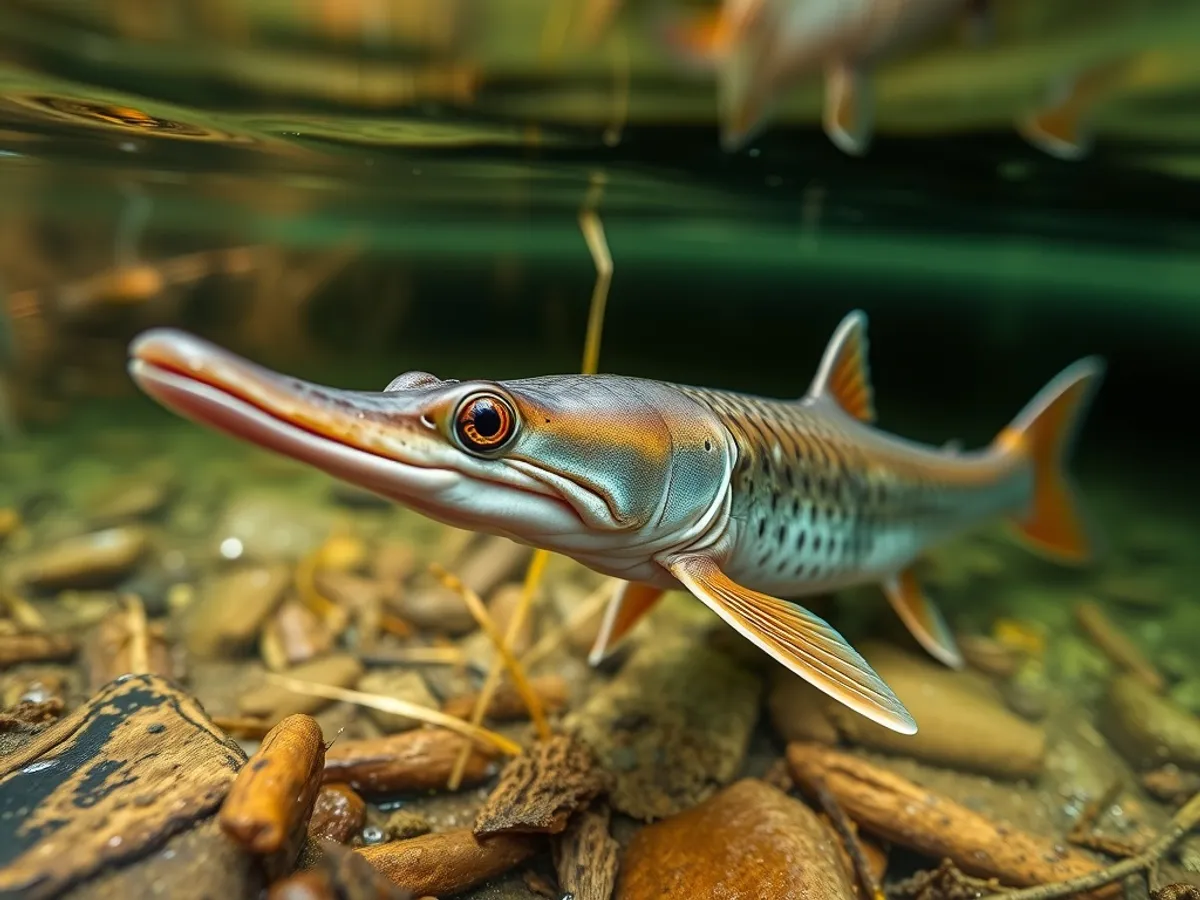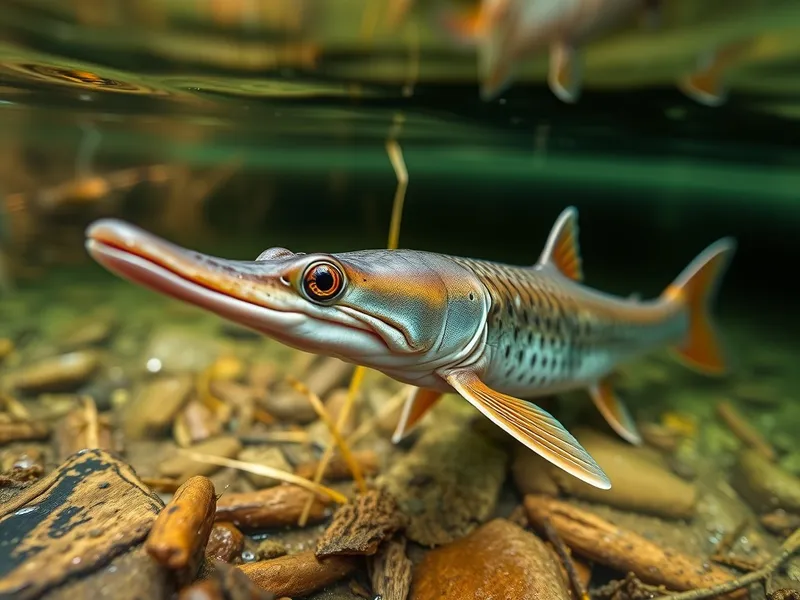
Longnose Gar
Lepisosteus osseus

Meet the Longnose Gar
The Longnose Gar is a distinctive freshwater fish known for its elongated body and especially long, narrow snout filled with sharp teeth. This prehistoric-looking species is covered in hard, diamond-shaped ganoid scales, offering effective protection against predators. Native to North America, the Longnose Gar is commonly found in slow-moving rivers, lakes, and backwaters, where it often lurks near the surface. Its ability to gulp air allows it to survive in low-oxygen environments, making it highly adaptable.
Classification
Fish
Habitat
Freshwater rivers, lakes, and backwaters
Diet
Carnivore
Lifespan
15-20 years
Conservation
Least Concern
Weight
2-7 kg
📖Fascinating Facts
Toothy Predator
The Longnose Gar's long snout is filled with sharp, conical teeth perfectly adapted for catching fish and other prey.
Armored Body
Their bodies are protected by thick, interlocking ganoid scales that make them resistant to most predators and even fishing hooks.
Air Breather
Longnose Gar can breathe atmospheric air, allowing them to inhabit waters with very low oxygen levels where few other fish can survive.
📋Detailed Description
The Longnose Gar (Lepisosteus osseus) is a large, elongated fish reaching lengths of up to 2 meters (6.5 feet), though most adults average between 0.7 and 1.2 meters (2.3–4 feet). Its most distinctive feature is its extremely long, narrow snout, which can comprise up to 20% of its total body length and is lined with sharp, conical teeth adapted for grasping slippery prey. The body is armored with interlocking, rhomboid ganoid scales composed of ganoine, a hard, enamel-like substance, providing exceptional protection against predators and parasites. The dorsal and anal fins are set far back near the tail, aiding in sudden bursts of speed and maneuverability. Longnose Gars have a heterocercal tail (upper lobe longer than lower), a primitive feature among bony fishes. Their coloration is typically olive-brown to greenish above, with a lighter, sometimes yellowish belly, and dark spots on the fins and body. They possess a spiral valve intestine, a trait shared with sharks and some ancient fishes, which increases digestive efficiency. Longnose Gars are facultative air breathers, possessing a vascularized swim bladder that functions as a lung, allowing them to survive in hypoxic (low-oxygen) waters. This species is primarily solitary outside of the breeding season and is most active during twilight and nighttime hours.
💡 Did you know?
Longnose Gar can leap out of the water to escape predators or catch prey, using their powerful tails.
🔬Research & Sources
Wikipedia Summary
The longnose gar, also known as longnose garpike or billy gar, is a ray-finned fish in the family Lepisosteidae. The genus may have been present in North America for about 100 million years. References are made to gars being a primitive group of bony fish because they have retained some primitive features, such as a spiral valve intestine, but they are not primitive in the sense of not being fully developed.
Last Modified: 5/16/2025
🎭Behavior & Social Structure
Longnose Gars are ambush predators, relying on stealth and patience to capture prey. They often remain motionless near submerged vegetation or logs, blending into their surroundings before making rapid lateral lunges to seize fish, crustaceans, or insects with their tooth-filled jaws. Their feeding is primarily crepuscular and nocturnal, though they may be seen basking near the surface during the day, especially in warmer months. Social interactions are minimal outside of spawning aggregations, and individuals maintain loose territories. Juveniles may form small schools for protection, but adults are largely solitary. Longnose Gars are known for their ability to leap out of the water when startled or during feeding. They exhibit site fidelity, often returning to the same resting or feeding spots. During periods of low oxygen, they surface periodically to gulp air, a behavior that allows them to exploit habitats unsuitable for most other fish.
👶Reproduction & Life Cycle
Spawning occurs in late spring to early summer (April–June), when water temperatures reach 20–26°C (68–79°F). Males and females migrate to shallow, weedy areas of rivers, lakes, or floodplains, often forming groups with several males attending a single female. Females release adhesive eggs over submerged vegetation or debris, which are then fertilized externally by the males. A single female can lay between 4,000 and 77,000 eggs per season, depending on her size. The eggs are highly toxic to most vertebrates, including humans, providing protection from predation. There is no parental care; adults leave the spawning grounds after egg deposition. The eggs hatch in 6–9 days, and the larvae use an adhesive organ on their snout to attach to vegetation until their yolk sac is absorbed. Juveniles begin feeding on zooplankton and small invertebrates before shifting to piscivory as they grow.
🛡️Adaptations & Survival
Longnose Gars exhibit several evolutionary adaptations for survival in variable freshwater environments. Their ganoid scales form an armor that deters most predators and resists parasitic infection. The elongated snout and sharp teeth are specialized for capturing fast, slippery prey. The spiral valve intestine increases nutrient absorption, an ancient trait retained from early actinopterygians. The vascularized swim bladder enables bimodal respiration, allowing the gar to extract oxygen from both water and air, a crucial adaptation for surviving in warm, stagnant, or hypoxic waters. Their cryptic coloration and ability to remain motionless aid in both ambush predation and predator avoidance. Additionally, their eggs' toxicity reduces predation pressure on early life stages.
🎨Cultural Significance
Longnose Gar have played a minor but notable role in the folklore and traditions of Indigenous peoples and early settlers in North America. Their scales were historically used as arrowheads, jewelry, and decorative items due to their hardness and iridescence. In some regions, gars are featured in local legends as symbols of resilience or as cautionary figures due to their fearsome appearance. Modern interest in Longnose Gar has increased among sport anglers, who value them for their size and fighting ability, though their flesh is not widely consumed. The toxicity of their eggs is well known among traditional fishing communities.
🔬Recent Research & Discoveries
Recent research has focused on the evolutionary history of gars, revealing that the Lepisosteidae lineage dates back to the Cretaceous period, making them living fossils with many primitive features. Genomic studies have provided insights into the development of their unique ganoid scales and bimodal respiration. Ongoing ecological studies are examining their role as apex predators in freshwater ecosystems and their potential as bioindicators of water quality. There is also interest in their resilience to hypoxia, which may inform research on fish physiology and adaptation to climate change. Conservation genetics is being used to assess population structure and connectivity across their range, with implications for management and habitat restoration.
🎥Wildlife Videos

Longnose Gar facts 🐟 Longnose garpike 🐟 Billy Gar 🐠 a ray-finned fish
The longnose gar, also known as longnose garpike, and billy gar, is a ray-finned fish. There are references to gars being a ...
Amazing Planet!

"Longnose Gar: The Prehistoric Predator with Patience and Precision"
In this fascinating video, we take a closer look at the **Longnose Gar**, a prehistoric predator that has survived for millions of ...
Vuong Nguyen channe03

Up Close with the Alligator Gar (4K Documentary) | Biggest & Baddest
Biologist Niall McCann travels around the world investigating legendary, large or fierce animals - getting closer than most humans ...
Our World

Longnose Gar: A Prehistoric, Patient, Predator
DNR Ichthyologist John Lyons gives a hands-on lesson about the Longnose Gar, one of two Gar fish species in Wisconsin.
WIDNRTV

Ky Wildlife Shortnose Gar
Episode 52.
Hughes outdoor adventures

Japan's Secret Water garden - David Attenborough | National Geographic Documentary 2023
Japan's Secret Water garden - David Attenborough | National Geographic Documentary 2023 #Wildlife #Documentary #Animals ...
FreeDocuAnimals
🌍Habitat Information
The Longnose Gar typically inhabits Freshwater rivers, lakes, and backwaters environments. Longnose Gars have adapted to their environments with specialized features and behaviors.
Primary Habitat:
Freshwater rivers, lakes, and backwaters
More detailed habitat information will be available soon.
🛡️Conservation Status
The Longnose Gar is currently classified as Least Concern. Conservation efforts are crucial for preserving this species for future generations.
Common Threats:
- 🏠Habitat loss and fragmentation
- 🌡️Climate change impacts
- 🎯Hunting and poaching
- 🏭Human-wildlife conflict
⚠️Threats & Conservation Challenges
Currently classified as Least Concern by the IUCN, Longnose Gar populations are stable across much of their range. However, localized threats include habitat loss from river channelization, dam construction, and wetland drainage, which reduce spawning and nursery habitats. Pollution, especially from agricultural runoff and industrial sources, can degrade water quality and affect reproductive success. Historically, gars were persecuted as 'trash fish' and targeted for removal due to misconceptions about their impact on game fish populations, leading to localized declines. Today, they face incidental capture in commercial and recreational fisheries, but regulations and increased awareness have reduced direct persecution. Climate change poses a potential long-term threat by altering hydrological cycles and water temperatures.
🔬Scientific Classification
Scientific Name
Lepisosteus osseus
Classification Hierarchy
🔍 About Taxonomic Classification
Taxonomic classification is a hierarchical system used by scientists to classify and organize living organisms based on shared characteristics and evolutionary relationships.
The system moves from broad categories (Kingdom) to increasingly specific ones, with each animal's scientific name typically consisting of its Genus and species.
📝Community Notes
Share your observations and insights about the Longnose Gar with our community of wildlife enthusiasts.
Join Our Community
Sign in to share your observations and connect with fellow wildlife enthusiasts.
Sign In to ContributeNo community notes yet
Be the first to share your observations about the Longnose Gar!
Explore Longnose Gar
Select a tab above to learn more about this amazing animal.
📸Photo Gallery
No photos available for this animal yet.
🌟Discover More Wildlife
Continue your journey of discovery with more fascinating animals from our database
